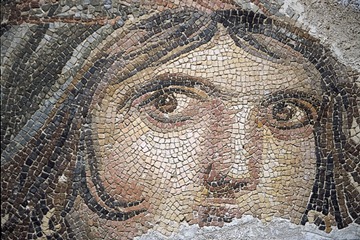Mosaics unearthed from the ancient city of Zeugma are to be exhibited at the Gaziantep Mosaic Museum, to hold the world’s second largest collection of its kind, following the Bardo Museum in Tunis. The mosaics will be on view for visitors about three months from now.
 At this point, small repairs are being made, and Gaziantep Mayor Asım Güzelbey notes that the museum complex is the largest in the history of the Turkish Republic. Says Güzelbey: “What we [originally] envisaged here was the Zeugma Mosaic Museum Congress and Cultural Center. The complex was constructed on a site covering 40,000 square meters. It is a stupendous complex, with a seating area of 12,000 square meters and a total of 30,000 square meters of closed space. We had originally planned this museum as a combination archeology and mosaic museum. But in the end, we decided to create just a mosaic museum [calling it the Gaziantep Mosaic Museum] as Gaziantep is a mosaic center, and we need to display many mosaics.”
At this point, small repairs are being made, and Gaziantep Mayor Asım Güzelbey notes that the museum complex is the largest in the history of the Turkish Republic. Says Güzelbey: “What we [originally] envisaged here was the Zeugma Mosaic Museum Congress and Cultural Center. The complex was constructed on a site covering 40,000 square meters. It is a stupendous complex, with a seating area of 12,000 square meters and a total of 30,000 square meters of closed space. We had originally planned this museum as a combination archeology and mosaic museum. But in the end, we decided to create just a mosaic museum [calling it the Gaziantep Mosaic Museum] as Gaziantep is a mosaic center, and we need to display many mosaics.”
There are a total of 2,500 square meters of mosaic work to be displayed in this museum. What this means is that Gaziantep is to possess the world’s second largest mosaic collection, second only to that of the Bardo Museum in Tunis.
“The number of mosaics displayed at Tunis’ Bardo Museum is around 2,000. This number increases if we include the mosaics nearby, which is also the case for the museum in Gaziantep. Of course, we need to confirm this information. But I took a tour of the Bardo Museum around six years ago, and it really was a wonderful museum. The presentation there is just beautiful. In the year 1864, an Ottoman pasha called Ali Pasha built a palace there. Later, France turned this palace into a museum. Nowadays, pieces are on display at the museum. In Gaziantep, we are using all the examples of modern museum planning.”
The inner sections of the new mosaic museum are now finished, with the transfer of the mosaics from the Gaziantep Museum continuing. Noting that the transfer of the mosaics is occurring simultaneously with certain repairs, Güzelbey says: “The plans are for the museum to be finished by the month of February. And in April, the expectation is that visitors can start coming to see the exhibits. It is possible that these dates may change, may come a bit later. We need around two or two-and-a-half more months to complete the museum and bring it to a finished state ready for tours. And I believe that when it is finished, it will change Gaziantep’s profile as a city. I think that the number of visitors to Gaziantep will double compared to the past because the city will boast the largest mosaic museum in Turkey, perhaps in the world. This is an extremely important development. We can see the museum as a great argument for why Gaziantep should be taking its share of the tourism pie. And while Gaziantep is known as an industrial city, at the same time, it has started to become known for its cultural and historical past and identity and thus is seen as a cultural city. Gaziantep has started to be viewed as a spot where cultural tours come to visit. And of course, all this is the result of careful and planned programming.”
Güzelbey also touches on the difficulties associated with trying to keep and protect mosaics in their original places. He recalls the 1997 incident when the Dionysus wedding scene mosaic was stolen by thieves who didn’t even break the iron caging around it, but instead tunneled up underneath the mosaic to get it. The mayor notes that there is still no information as to the whereabouts of this mosaic. Güzelbey underscores that for purposes of both safety and presentation, displaying these mosaics in one museum will be a much more beneficial situation.
He adds: “Of course, you cannot just build a museum every time a mosaic turns up. Our state doesn’t have the funds for this, nor is it technically possible. People who come specifically to see these mosaics will prefer being able to enjoy them all gathered in one spot, rather than having to go from place to place to see them. And so we can really view this museum as a contribution to people’s culture. I do believe that every mosaic unearthed in this region should be exhibited in the new Gaziantep Mosaic Museum.”
Author: Adem Yilmaz | Source: Today’s Zaman [January 03, 2011]















